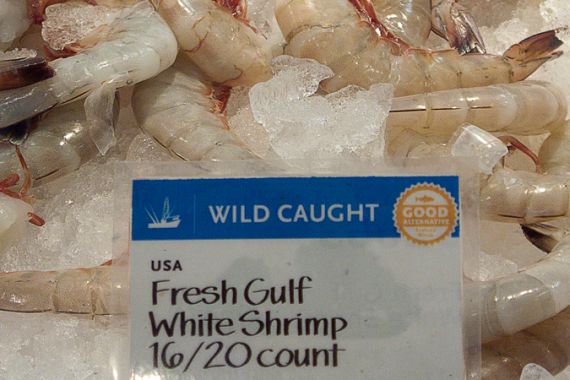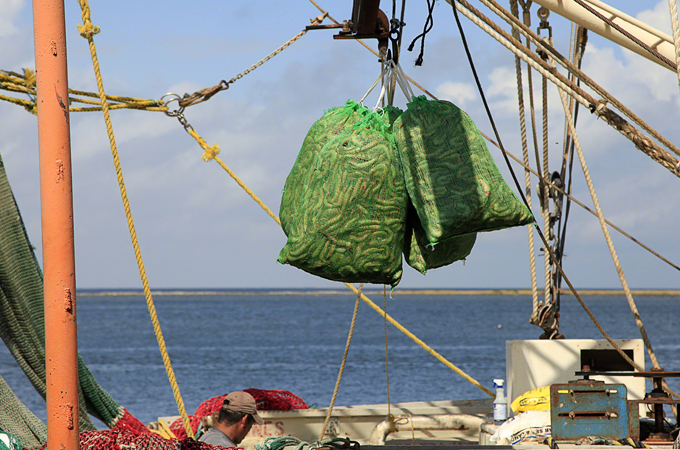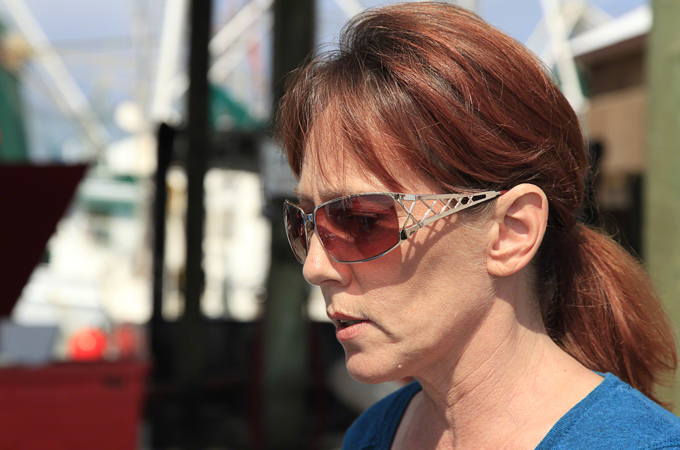Is the Gulf of Mexico safe?
Experts, fishermen and residents disagree with federal agencies’ claims that the Gulf and its seafood are safe.

 |
| Gulf shrimp being offloaded at Dean Blanchard Seafood Distributors, Grand Isle, Louisiana [Erika Blumenfeld] |
Gulf Coast residents, fishermen, seafood distributors, and scientists believe that living on the coast and eating seafood from the Gulf has become hazardous to their health.
In response to their oil disaster last summer that released at least 4.9 million barrels of oil into the Gulf of Mexico, BP admitted to using at least 1.9 million gallons of widely banned toxic Corexit dispersants (which have been banned in 19 countries) to sink the oil. The dispersants contain chemicals that many scientists and toxicologists have warned are dangerous to humans, marine life, and wildlife.
Keep reading
list of 4 itemsWorld’s coral reefs face global bleaching crisis
Why is Germany maintaining economic ties with China?
Australia’s Great Barrier Reef suffers worst bleaching on record
Earlier this year on May 20, the EPA told BP it had 24 hours to find a less toxic alternative, but the EPA’s request was ignored. Then on May 25, BP was given a directive by the EPA to scale back their spraying of the Gulf of Mexico with dispersants. The Coast Guard overlooked the EPA’s directive and provided BP with 74 exemptions in 48 days to use the dispersants.
A March 1987 report titled Organic Solvent Neurotoxicity, by the National Institute for Occupational Safety and Health (NIOSH), states: “The acute neurotoxic effects of organic solvent exposure in workers and laboratory animals are narcosisanaesthesiaia, central nervous system (CNS) depression, respiratory arrest, unconsciousness, and death.”
Several chemicals and chemical compounds listed in the NIOSH report, such as styrene, toluene, and xylene, are now present in the Gulf of Mexico as the result of BP’s dispersants mixing with BP’s crude oil.
Government testing repudiated
On October 29 the US Food and Drug Administration (FDA) and National Oceanic and Atmospheric Administration (NOAA) announced in a press release, new chemical testing for BP’s dispersants.
Prior to the federal government’s announcement, a “rigorous sensory analysis” (a sniff test), was the only measure in place to test seafood samples for dispersant contamination. According to the press release, the new testing measure checks for the level of dioctyl sodium sulfosuccinate (known as DOSS), a major component of the dispersants.
Surprisingly, the press release admits to dispersant chemicals being present in some of their seafood samples: “Using this new, second test, in the Gulf scientists have tested 1,735 tissue samples … Only a few showed trace amounts of dispersants residue (13 of the 1,735) and they were well below the safety threshold of 100 parts per million [ppm] for finfish and 500 parts per million for shrimp, crabs and oysters.”
“This test adds another layer of information, reinforcing our findings to date that seafood from the Gulf remains safe,” Jane Lubchenco, undersecretary for commerce and NOAA administrator, said of the test.
However the press release does not specify which type of analytical testing was carried out on what types of seafood, nor what the “trace amounts of dispersants” were. Al Jazeera’s requests last week for this information from both NOAA and the FDA have not been answered.
Hugh Kaufman is a senior policy analyst at the Environmental Protection Agency’s (EPA) office of solid waste and emergency response. Kaufman, a leading critic of the US government’s decision to use Corexit, told Al Jazeera this about the press release: “They say it perfectly clear: the purpose of the test they developed is to make the public confident, not whether the seafood was safe or not.
“They selected the one compound that doesn’t bio-accumulate, as opposed to testing for the toxic ingredients that have a low safety threshold and do build up in tissue. They are not looking for those.”
Kaufman, who has been the EPA’s chief investigator on several contamination cases, including Love Canal and Times Beach, said: “They want to be able to tell the public the seafood is safe. But if you are going to test seafood to see if it’s safe or not, you want to test for the ingredients of Corexit that have a low safety threshold and do bio-accumulate in tissue.”
“However, if you want the public to think everything is fine, then you do what they said in their press release they are doing, which is to look for an ingredient with a high safety threshold that doesn’t build up in tissue.”
“They told you they are doing a cover up, how they are doing the cover up, and notwithstanding that, they still have some positive results for chemicals.”
Inaccurate safety levels
Chemist Bob Naman with the Analytical Chemical Testing Lab in Mobile, Alabama, has been testing samples from across the Gulf for oil and dispersant also takes issue with these recent government statements.
“500 ppm is an incredible amount,” Naman explained to Al Jazeera, “I don’t know what moron set that level, but 500 ppm is an extreme amount. It is probably 100 times too high. A reasonably insignificant number would be five parts per billion [ppb], not something being tracked in ppm.”
Naman gave an example of a government standard that seemingly undermines information in the recent press release.
“The amount of chemicals the EPA allows in storm water draining from a site containing salvaged cars into a body of water is 15 ppm,” he said.
“If the EPA won’t allow more than 15 ppm of that, why in the hell would they consider a number that is 33 times higher than that as acceptable for something you are going to put in your body? Their people that are setting that kind of number apparently don’t have a clue what that number even means. The threshold limits they are setting are extremely absurd to a chemist like me. I’m appalled they would use such high numbers for their thresholds.”
Naman also expressed concern over the fact that from his understanding neither the FDA nor NOAA are testing for propylene glycol and 2-butoxyethanol, the two marker chemicals for BP’s dispersants.
“Since they are testing in ppm, these two marker compounds are not being picked up,” Naman said.
“They are not using low enough detection limits. They need to be looking for parts per billion, not parts per million. It’s a world of difference.”
The EPA’s website states that, “EPA believes dispersants should only be used sparingly and when absolutely necessary,” yet conversely stated that while BP’s well was gushing oil, “[dispersants] appeared to be having a positive effect on the oil at the source of the leak and thus far has had no significant ecological impact”.
Al Jazeera requested information from the EPA’s Region 6 Public Information Centre about their ongoing testing of the water and air for chemicals associated with the oil disaster, also asking for information the EPA has that is related to illnesses caused by the oil disaster.
Last week we were told by Joe Hubbard in EPA’s office of external affairs that this information would be provided, but Al Jazeera has yet to receive this information.
Kaufman believes one of the main problems with federal response to the oil disaster is that, “BP called most of the shots, and that was the problem, and clearly from this press release, looks like they still are. The more the public thinks everything is back to normal, the less people who were harmed by the mess will be reimbursed. Follow the money”.
 |
| Karen Hopkins at Dean Blanchard Seafood Distributors, Grand Isle, Louisiana [Erika Blumenfeld] |
Seafood concerns
Fisherman from Louisiana and Florida have voiced their concerns to Al Jazeera about the safety of seafood they are catching.
Karen Hopkins, who works for the seafood distributor Dean Blanchard Seafood, in Grand Isle, Louisiana, told Al Jazeera: “I will never again eat any seafood that comes from the Gulf of Mexico.”
Clifford Troxler, also from Louisiana, worked in the seafood distribution business for 25 years, and told Al Jazeera: “You couldn’t force feed me a shrimp from the Gulf.”
Hopkins is also concerned about what she sees as an attempt by the federal government to shift responsibility of seafood safety “away from BP and the feds and placing it square on the shoulders of fishermen and distributors”.
Hopkins provided Al Jazeera with a letter from Best Sea-Pak, a seafood distributor Dean Blanchard Seafood works with, that says: “Due to the recent Deepwater Horizon oil spill in the Gulf of Mexico and customers concerns of oil tainted seafood, we must implement measures to prevent oil tainted seafood from entering the food supply.
“A new mandatory requirement by the United States Food and Drug Administration is to ensure no fish (seafood) may be harvested from an area that is covered by a Local, State, or Federal closure or for which there is additional information that indicates potential hazards related to an oil spill.”
“Our lawyers looked this over and told us it is basically an attempt to make us and the fishermen take full responsibility for the seafood, even though it has been BP and the feds that have pushed to open up all the previously closed waters for fishing,” Hopkins said.
“That means that we’ll be the ones who get sued if somebody gets sick from contaminated seafood, instead of BP or the feds, who are the ultimately the responsible parties for all of this in the first place.”
Ongoing sickness
Al Jazeera is finding a growing number of people along the Gulf Coast who are exhibiting symptoms they attribute to chemical poisoning and exposure to BP’s oil and dispersants.
Susan Price is a small business owner who lives in Chauvin, Louisiana. While volunteering for a community outreach program in Grand Isle, Louisiana in late August, Price became ill.
“When I drove over the bridge to Grand Isle, I felt heavy exposure to chemicals,” Price told Al Jazeera. “My nose instantly clogged, I began to cough, my throat hurt, my voice became instantly hoarse, and my tongue felt and tasted like I’d licked a battery.”
A return trip to the island a short while later brought her symptoms back, so Price saw a doctor.
“I was diagnosed with pneuminitis, which is an inflammation of the lungs that the doctor told me is caused by inhalation of chemicals,” Price said. “He gave me an inhaler and pumped me up with antibiotics, but I’m still sick.”
Furthermore, Price said that while she was engaged in her community outreach work on Grand Isle, “every person I was dealing with was sick and had the same symptoms I did. Those people that are living there, heaven help them”.
Donny Matsler, a commercial fisherman from Dauphin Island, Alabama, has been suffering acute symptoms for months that have led him to several emergency room visits, time in intensive care, and finally to detoxification treatment with Dr William Rea in Dallas, Texas, at the Environmental Health Center.
The centre tests and treats human health problems related to chemical exposure, among other environment related ailments.
“Dr Rea told me I am Corexit-drunk,” Matsler told Al Jazeera, “My wife is the same, and everybody in Dauphin Island is sick from this stuff.”